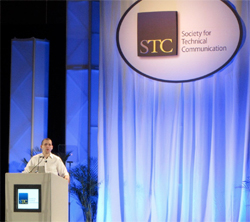
One of the things I like to do when I'm in the booth is ask people what they liked about Summit. I think STC does a good job putting the hot topics in front of its members and then bringing in people with good opinions about those topics. I am always surprised to see what topics are referenced the most. This year, three topics bubbled to the top: change, new ways to look at workflows, and multi-platform mobile devices. These are great topics, and really, they are all related. I'd like to shed a little light on how we at WebWorks look at these topics, but to cover all three would be far too broad for a single blog post. So, I will cover change in this blog post and follow with posts about workflow and multi-platform mobile devices. Now let's look at the topic of change.
There are many good techniques for implementing change in the workplace, but first, it is important to understand why change is needed so that the implementation can be on track. Change in the workplace is needed because the technical communication industry is changing. If you follow the timeline of help documentation, you'll see that for a very long time, the only medium available was a printed manual. This left a lot to be desired when it came to accessibility because if you didn't have the manual with you, then you didn't have access to help. I remember when I was growing up, we had a drawer in the kitchen for all our manuals. There was no organization at all, but if we needed a manual, we knew it was in that drawer, which we nicknamed the “Smithsonian.” Sometimes I would go through it and find manuals of appliances we owned in a different era and then act like I had just found a hidden treasure (like the Acme horse buggy's whip user guide).
But like all industries, technology would bring a change to help documentation and the technical communication industry. In the '80s, the personal computer brought desktops to the consumer world and created a need for electronic documents. PDFs emerged as the standard electronic manual. They still held the format of a printed document, but they could link TOCs, which made it a little easier to search for topics. It wasn't perfect, but it was the best technology at the time. Companies adapted the idea of PDFs quickly because they no longer had to worry about printing or shipping costs.
I personally believe this is when technical communications began to be spotlighted in the debit column of business ledgers. This change put a mindset in managers' heads that technical communication was a business expense and, to manage it properly, they had to look for a way to cut costs.
The next stage in the evolution of technical communications came via Al Gore and his birth child, the Internet (chuckle). Users wanted URL availability for their help content. It seems logical that most people who used a computer would have a hard time remembering a location in a file directory, but they sure as heck could remember anything that was preceded by a “www.” Also, HTML allowed for the introduction of some very rich features with help sets, such as:
- Multiple ways to express a message or add company branding without having to follow the guidelines of PDF, CHM, or other localized output.
- Search features for whole document sets and real-time updates through centralized storage of the help set.
Still, there was one barrier that remained: accessibility. Users were either bringing a desktop computer with them or using a manual to access content. If only there were some way to make a computer smaller to give the user some mobility. Now we enter today—the era of Apple's reinvention of the phone, and the dawning of MOBILE TECHNOLOGY. (You were supposed to hear a booming voice when reading that phrase. If you didn't, I would suggest going back and reading it again to get the full effect because mobile technology is really pretty cool.) I would like to add a disclaimer at this point. I understand that I have left out a few things in this timeline, but keep in mind this is a blog post, and I am trying, unsuccessfully I realize, to keep this short. I am also looking at this from a business point of view. We are trying to understand why we need to change the industry, or the workplace. The points I have illustrated on the timeline really did not become a factor for all businesses until they were widely adapted by the market. Businesses do not make changes unless they are certain they will be adopted by a larger proportion of the market. Good businesses make a specific change before that adaptation, while great businesses lead the change. Take, for example, the notebook computer. It has experienced some huge improvements in power, weight, and size, but more people are turning to their phones because they can ACCESS them almost anywhere. That means mobile adaptation is a HUGE concern for businesses . . . which brings me to my final observation.
Why is this evolution of help documentation tied to technology? I mean, really, who cares when and how you get your help documentation? To get in the right mindset for the answer, I want you to think about this: Back when PDFs first came out and managers were looking to cut expenses, why didn't they just cut out the help manual all together? Because clients, customers, patrons, or whatever you want to call them have always wanted relevant, focused, and accessible help documentation. The exciting part is that they've never really been 100% satisfied with the options that were out there, but with today's advancements in technology, they now know they can get the help they need in the format they want. Thus, today, help documentation is shifting from being a “need” to a “demand.” Needs are cool because if you meet a customer's need, then you generate revenue for your company. Demands separate businesses into two columns—winners and losers—because if you can't meet the customer's demand but your competition can
